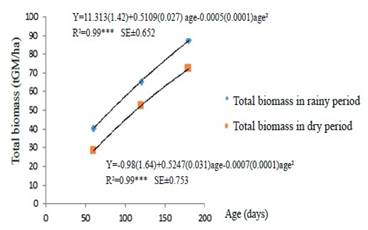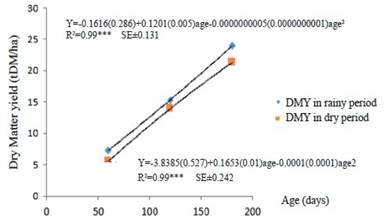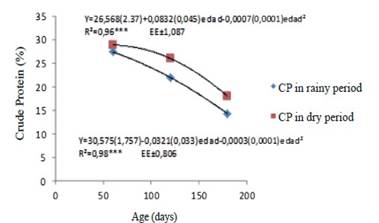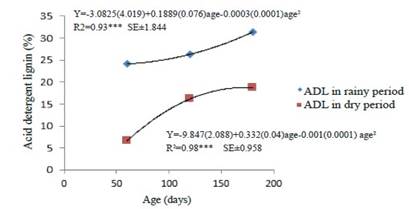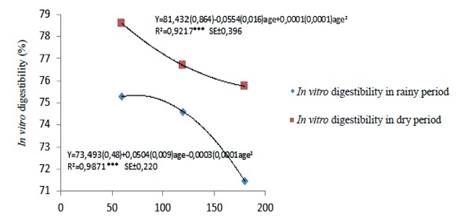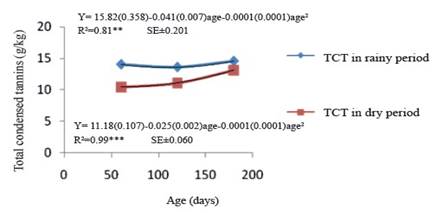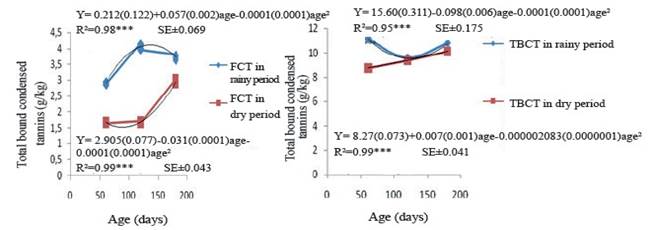Introduction
The tropical zone contains the greatest genetic diversity in the world, which is expressed in the large number of vascular plants per unit area. However, despite this richness, animal feeding models have been mainly based on the use of few plant species. This becomes more effective in the case of forage trees and shrubs that have not been properly used as food for animals. In the study of food systems used in hot climates, it is suggested that the sustainability of the system depends, to a large extent, on the use of different local biological resources (Holguín et al. 2015). This concept calls for expanding the use of species diversity as suppliers of forage for animals. Given the diversity of forage species, there is an urgent need to study and recommend promising species for specific agro-ecological environments and biomass production systems, taking into account mainly their nutritional value.
Given the characteristics of tropical pastures, with low values of digestible protein and high fiber rate, it has been demonstrated that the foliage of shrub or tree legumes can be a nutritional strategy in the ruminant supplementation in the tropics, mainly during the periods of forage scarcity (Mejía-Díaz et al. 2017). Many of these species have higher nutritional values than those of the pastures and may produce high amounts of edible biomass that are more sustained in time than those of the pasture without fertilization (Gutiérrez et al. 2015).
There is evidence that species of non-leguminous plants such as Tithonia diversifolia accumulate as nitrogen in their leaves as legumes, has high phosphorus content, large root volume, special ability to recover the few nutrients from soil, wide range of adaptation, tolerance to acidity conditions and low fertility in the soil, endures cutting at soil level, has rapid growth and low demand for inputs and management for its cultivation (Ruíz et al. 2014). In addition, information is available on their use in cattle feed (Mauricio et al. 2014), which includes silvopastoral systems (Mejía-Díaz et al. 2017).
Currently, due to the great diversity of forage trees and shrubs, the study of promising species for specific agroecological environments and livestock production systems is a necessity, depending on the biomass productivity or its nutritional value, so the characterization of yield and its components, as well as the nutritional valuation of Tithonia diversifolia in different stages of development, constitutes the objective of this study.
Materials and Methods
Experimental area and climatic conditions. The study was carried out in the Polygon of Animal Production of the University of Granma, located 17 1/2 km from the city of Bayamo, Cuba. An area with half a hectare of Tithonia diversifolia with one year old was used. The study was carried out during dry (November-April) and rainy (May-October) periods of the years 2006-2007. The soil present in the experimental area is brown with carbonate (Hernández et al. 1999), with a pH of 6.2; the content of P2O5, K2O and total N was 2.4; 33.42 and 3.0 mg/100g of soil, respectively and 3.6 % of organic matter.
During the experimental period, the climatic factors behaved as follows: during dry season, rainfall reached 253.7 mm, mean, minimum and maximum temperatures were 24.43; 19.4 and 31.53 ºC, respectively and mean relative humidity of 78.17 %, while in the rainy season, precipitations were of 908.9 mm, with mean, minimum and maximum temperature of 26.67; 22.18 and 34.05 ºC, respectively and 81.83 % of relative humidity.
Treatments and experimental design. A randomized block design was used, with four replications. Treatments consisted of the three regrowth ages (60, 120 and 180 days).
Sampling. At the beginning of the evaluation in each period, a uniformity cut was made at 15 cm of soil height (November and May for dry and rainy period, respectively). An area of 0.5 ha, divided into plots for each age of regrowth (60, 120 and 180 days), was used. The land was not irrigated nor fertilized during the experiment. Plots consisted of 99 % of the species to be evaluated and 1 % of grasses belonging to Dichantium genus and Ciperaceae family.
For yield components, 10 plants were taken at random for each of the ages and then the rest of the area of the plot was cut, eliminating 50 cm of border effect. After green weight of the harvested plants, leaves, petioles and stems smaller than 2.0 cm (edible biomass) and the thickest stems were separated and weighed individually. Later, plant material was homogenized and samples were taken, which were dried in an air circulation oven for 72 hours at 65 °C. For this, 200 g of each sample was used.
Chemical analysis. Percentages of DM, CP, OM and silica were determined according to AOAC (2000) and NDF, ADF and lignin according to Goering and van Soest (1970).
In vitro degradability of dry matter. The protocol recommended by the manufacturer was used for the DaisyII® incubator (ANKOM Technology, Fairport, NY-USA 2000), with FN°57 bags, pore size of 25 μm and dimensions of 5 x 4 cm made of polyester/polyethylene with extruded filaments in a three- dimensional matrix, in each of which 0.25 g of sample was deposited, to obtain an effective area per bag of 36 cm2 which corresponds to a relation of sample size and bag surface area of 14.4 mg / cm2 and were sealed with heat. In each of the four digestion jars, a replication of each of the ages of this species was randomly incubated, including a control bag (empty and sealed bag without sample) in order to generate the correction factor for the possible entry of particles or weight loss of bags. The procedure was carried out by duplicate.
The functioning principle of the DaisyII® is to establish incubation conditions similar to in vivo conditions, in such a way that the procedure includes solutions composed of minerals, nitrogen sources and reducing agents that help the necessary anaerobiosis (continuously gassing with CO2). In the process, 4 glass containers of 4 L capacity were used in which 2 L of a mixture of ruminal liquid and culture medium (1: 4 v/v) were added. The ruminal fluid was extracted from a group of eight adult Merino sheep, filtered through four layers of gauze, its pH was immediately determined and the mixture (equal parts) of ruminal fluid from animals that received the same ration was produced.
Samples were incubated for 48 h in the DaisyII® at 39.2 ± 0.5 °C, with constant circular agitation. After incubation, bags were washed with cold water, in order to stop the fermentation, and dried in a forced air oven at 105 °C for 2 h.
Secondary metabolites. Quantification of total phenols (TP) and total tannins (TT) was performed by the Folin-Ciocalteu method, before and after the treatment of the extracts with Polyvinylpolypyrrolidone, (Makkar 2003a), while total condensed tannins (TCT), free condensed tannins (FCT) and total bound condensed tannins (TBCT) were determined by the nButanol/HCL/Fe3 + method (Porter et al. 1986).
Statistical analysis. To establish the functional relationship between the different evaluated indicators and age, the linear, quadratic, cubic and Gompertz equations were analyzed. For the selection of the best fit equation, a high value of R2, high significance, low standard error of estimation and terms, significant contribution of the terms and of the equation according to Guerra et al. (2003) and Rodríguez et al. (2013) were taken into consideration. For all the above, the SPSS program (Visauta 1998) was used.
Results
The total biomass increased (P <0.001) with the plant age in the two seasonal periods and quadratic regression equations were fitted between this indicator and age. In the rainy period, values of up to 90 tGM/ha were reached at the age of 180 days, being this period the one with the highest yields (figure 1).
Dry matter yield increased (P <0.001) with regrowth age (figure 2) and quadratic regression equations were adjusted between the two variables for the two periods (rainy and dry). The highest values were registered in the rainy period and, after 120 days, higher yields were obtained at 12 tDM/ha/cut in both seasonal periods.
Dry matter percentage increased (P <0.001) up to 180 regrowth days (figure 3) and quadratic regression equations were fitted between the two variables for the two periods (rainy and dry), which hardly varied between them.
In both seasonal periods, CP decreased (P<0.001) with the regrowth age until a value close to 14 % in the rainy period and 18.04 % for dry season, at 180 days. In both cases, quadratic regression equations were fitted between this indicator and regrowth age (figure 4).
The content of neutral detergent fiber (NDF), acid detergent fiber (ADF) and acid detergent lignin (ADL) were increased (P<0.001), in both periods, with regrowth age of and quadratic regression equations were fitted between these indicators and the age (figures 5 and 6). The high value of lignin exceeds 20 % in rainy period and 18 % in dry season, although with 180 days of regrowth.
In vitro degradability of dry matter (IVDDM) decreased (P <0.001) with the regrowth age in both seasonal periods and it is highlighted its value superior to 60%. The best percentages were obtained in dry season and quadratic equations were fitted with age (figure 7).
The content of total phenols (TP), during the rainy period, increased up to 120 days of regrowth and then decreased up to 180 days, while in dry season, they increased (P <0.001) with the regrowth age and the highest values were reached at 120 days in the rainy period and at 180 days in dry season (12.36 and 6.43 g/kg DM, respectively). Total tannins (TT) had similar performance to the TP, their highest concentration was obtained in the rainy period at 120 days with 5.36 g / kgDM (figure 8).
The content of total condensed tannins (TCT) did not vary between 60 and 120 days and then increased up to 180 days in the rainy period (P <0.001), while in dry season, they increased with the maturity of the plant (figure 9). The highest values (14.55 and 13.08 g/kgDM) were obtained at 180 days of regrowth in the rainy and dry season, respectively, and the quadratic equations were adjusted.
The content of free condensed tannins (FCT) increased until 120 days and then decreased until 180 days in the rainy period, while in dry season, they always increased until 180 days. The total bound condensed tannins (TBCT) decreased up to 120 days and then increased up to 180 days in rainy period and, in dry season, they increased until 180 days. Quadratic regression equations were fitted between these indicators and the age in both seasonal periods and highlights the values of 4.07 g/kgDM at 120 days for (FCT) and 11.16g / kgDM at 60 days for (TBCT) during dry period (figure 10).
Discussion
The deterioration of livestock ecosystems requires profound transformations in their exploitation, based on agro-ecological principles, where livestock systems are considered as an ecosystem and not as a simple technical-economic management, in such a way that its members (plants, animals, soil, climate, humans and technologies) are synchronically conected and allow their effective, efficient and productive use with positive economic, social and environmental results. This new vision requires knowledge of the laws that govern the functioning of each of the elements and processes that make up the system, with the purpose of maximizing the energy flow and material recycling (Del Pozo et al. 2008 and Gallego-Castro et al. 2017).
Tithonia genus is widely distributed in countries such as El Salvador, Ceylon, Colombia, Costa Rica, Cuba, Guatemala, Honduras, India, Mexico, Panama and Venezuela (Ríos 1999), which indicates its ability to adapt to different climate and soil conditions, so it is expected that due to the genotype-environment interaction different ecotypes are found.
Based on this principle, Tithonia diversifolia variety could be useful for the livestock systems of Granma province was studied, mainly because there is not enough information available about its performance under the specific conditions of Valle del Cauto.
Ruiz et al. (2010) conducted a survey in six provinces of Cuba and demonstrated the variability in growth and development indicators among the 29 collections made and established four groups with similar characteristics in the components of each group. Subsequently, when studying growth dynamics of two accessions, Ruiz et al. (2012a b) established that green weight of the accession 23 increased up to 18 weeks of regrowth, while accession 10 increased until week 12 and then decreased.
The increase of yield and biomass of Tithonia diversifolia with the age of regrowth can be attributed, among other factors, to the increase of the photosynthetic process and the synthesis of metabolites necessary for growth and development of plants, which brings about accumulation of dry matter (Romero and Leyva 2014).
Gallego-Castro et al. (2017) obtained, in Tithonia diversifolia, 20.75 and 4.95 t/ha of biomass and dry matter, respectively. These values are much lower than those of this research in the three studied regrowth ages, which can be determined by differences in management and edaphoclimatic conditions prevailing in the researches.
The percent of DM increased with the regrowth age determined, among other aspects, by the increase in yield as the plant ages and, with it, the increase of structural components of the plant. The studies of Meza et al. (2014) showed dry matter values of 19.1 %, similar to those found in this research at the age of 60 days, although climatic and soil conditions were different, which shows good adaptation of this species to the different edaphoclimatic conditions.
On the other hand, Herrera (2005) reported that as the plant advances in maturity, a physiological process occurs in the pastures and forages related to the control of water balance in the plant, in such a way that in the presence of humidity stress, they close the stomata and transpiration is reduced to avoid water loss, with the consequent increase of dry matter content. This is likely to help explain the performance of dry matter percent in this experiment.
The decrease of protein with regrowth age could be related to the reduction of the synthesis of protein compounds and to the increase of the synthesis of structural carbohydrates (cellulose and hemicellulose), although other factors like water availability and soil nitrogen could influence this performance (Meza et al. 2014 and Gómez-Gurrola et al. 2017).
In the present research, protein values were higher than 14 %, which was encouraging since no irrigation or fertilization was used. However, Meza et al. (2014), in this same species, obtained values of 18 % at 120 days of regrowth in dry season. These results were a little lower than those shown in this research due to the species, climatic and soil conditions.
The crude protein is obtained by multiplying total nitrogen content by the factor 6.25, so that this value contains all forms of nitrogen (organic and inorganic) present in the plant. Therefore, it would be essential to conduct future research to quantify the different forms of nitrogen such as NO3, NO2 and true protein, among others, which would improve plant management and make diets that do not produce alterations in the animal that consumes it.
The increase of ADF and NDF with age could be related to the physiological and anatomical changes that occur when the plant ages, which causes the decrease in the proportion of cytoplasmic cellular content. The cellular lumen is reduced with its soluble components and the fibrous components are increased (Rodríguez 2017). This is accentuated much more as the yield increases, due to the water balance of the plant and the amount of nitrogen available in the soil, among other factors.
The values of these constituents were important, because at advanced ages, the NDF and ADF did not exceed 50 and 32 %, respectively. Comparing these values with those reported in Cenchrus purpureus (Herrera and Ramos 2015), in several grasses (Ramírez 2010) and in legumes and trees (Verdecia 2015), they are inferior and this represents an advantage of Tithonia, since it does not accumulate much amount of fiber in its constitution and it is likely that the chemical structure of that fiber is different, which can influence on digestive efficiency when consumed by the animal.
The increase of lignin as the plant ages may be related to the degree of stiffness of the plant, resistance of vascular tissues, conduction of solutes, water and mineral salts necessary for its survival (Gutiérrez et al. 2015). Herrera et al. (2017a) found positive and significant correlations between lignin content and maximum temperature, rainfall and its distribution. However, the values obtained in this research are higher than those reported in the literature for other grass and legume species (Ramírez 2010, Herrera and Ramos 2015 and Verdecia 2015).
Lignin is one of the plant components with high complexity and little studied from the point of view of its properties and chemical composition. However, despite its theoretical and practical importance, the monomeric composition of lignin, in most of the tropical grass and legume species, is unknown. Another important element related to lignin is its chemical structure. Valenciaga et al. (2009) studied the chemical components of lignin in Pennisetum purpureum and established that its components hydroxybenzaldehyde, vanillin and syringylaldehyde were increased with the regrowth age as well as total lignin content. In addition, they pointed out that each of them increased with age in a specific way, as well as its influence on plant degradability. Considering this criterion, it is probable that monomeric composition of Tithonia is totally different and its constituent chain has greater length and weight. This probable hypothesis needs future research.
Total degradability of forage mass is a function of the relative proportion of each component of the plant and its individual degradability. On the other hand, the reduction of degradability with the increase of maturity is also influenced by the increase of structural components. In tropical pastures, in the first stages of growth, they present a thin cell wall, with little fiber, allowing an easy rupture and short digestion times. After maturity increases, the vascular structures of the leaves become thicker, as well as the vascular tissue and the sclerenchyma, leaves and stems are lignified and become physically stronger and difficult to reduce in size through the action of ruminal microorganisms, aspects that may be different in shrub species (Ortiz-González et al. 2014).
Degradability of dry matter decreased with age, although it is important to note that the values exceeded 70 % in the two seasonal periods, which undoubtedly is very important for the intake and use of animals with this forage. However, this result is not related to the contents of NDF, ADF or ADL, which are relatively high, especially lignin. Previously, the negative effect of lignin and its monomeric units on the degradability of forages had been reported (Valenciaga et al. 2009), which does not seem to be fulfilled in the present research. Therefore, specific future experiments are needed to clarify this performance.
Information on the content and performance of secondary metabolites in tropical forage grasses and legumes is not extensive, especially in Tithonia. However, in this research, a peculiar performance of TP, TT, FCT and TBCT was found in the rain period.
Regarding secondary metabolites (figures 8, 9 and 10), the poorly defined performance of the TP, as well as TT, while TBCT had a tendency to decrease with the regrowth age during the rainy period. However, FCT and BCT showed an increase with age. This performance could be related, according to Makkar et al. (1988), to the link between the concentration of tannins with the increase of biomass maturity, where the values of tannins do not remain static and that, in turn, concentrations were negatively related to the natural processes of senescence.
García et al. (2008), when studying different ecotypes of leucaena, found values of TP and CT of 55.5 and 55.2 g/kg DM, respectively. These authors stated that the tannin content may be influenced by the plant genotype and the environmental factors causing stress, among which water scarcity stands out. Romero and Leyva (2014), when studying the concentration of phenols and condensed tannins in Gliricidia sepium, found that the effect of season varied according to the nature of tannins, with the highest values of free and bound condensed tannins to the fiber (6.25 and 7.99 g/kgDM, respectively) during the rainy season.
On the other hand, Verdecia et al. (2014), when studying secondary metabolites TP, TT, TCT, TBCT and FCT in Neonotonia wightii, found that they increased with the regrowth age, while Herrera et al. (2017b), in Leucaena leucocephala, reported significant correlations of these metabolites with maximum temperature, minimum temperature, total rainfall and their distribution. This indicates the specific performance of these metabolites before climatic factors and genotype.
The increase in total phenols, total tannins and total condensed tannins is related to the increase of maturity of biomass and to the increase of lignin concentration (Makkar 2003b). Wambui et al. (2006), when evaluating the chemical composition of Tithonia diversifolia, found values for total phenols and total tannins of 10.6 and 5.6 g/kg DM, respectively. These results are similar to those obtained in this study during the rainy season.
Miller and Ehlke (1996) and McMahon (2000), when studying the concentration of condensed tannins, argued that this compound is controlled, primarily, by genetic factors and, secondly, by environmental variations. In general, its concentration increased with maturity and is associated with the increase of lignin in the tissues, which can cause a decrease of forage degradability, when high values are reached. In forage legumes, it has been reported that, from the total of condensed tannins, 90 % are total bound tannins, and approximately 70 % are bound to the protein, since, the higher the concentration of total condensed tannins, the greater the amount of tannins coupled to proteins, due to the affinity they have for this nutrient (Jackson et al. 1996) and also related to the reduction of cell wall degradability. Differences presented by tannins, in general, among the experimental periods, in this study, can be attributed to the variations of environmental conditions, to plant nutrition and to probable reactions of tannins with other compounds present, among other factors.
Hydrolyzable tannins can cause gastric bleeding and damage to the kidneys, but condensed tannins are related to the probable better digestion of proteins in ruminants and can protect them against helminthiasis (Makkar 2003b). Chew et al. (2011) noted the antioxidant and bactericidal characteristics, among others, of some of them. In addition, Makkar et al. (2007) reported that secondary metabolites have aroused interest in foods for human consumption, due to its potential to prevent cancer, circulatory disorders and viral infections, antioxidants and antibacterial, antiviral and antiparasitic effects, among other properties. However, their action mechanisms are not fully established. Therefore, it would be important to study these elements in plants used in Cuba for animal nutrition and human health.
Conclusions
Regression equations were established that explain the close relationship of age with yield, chemical composition, secondary metabolites and dry matter degradability in both seasonal periods.
The values of the phenolic compounds are below those reported in the edible fraction of some legumes of the production systems in the tropics, which demonstrates the quality of this species to be used in animal feed.
Future research is needed to explain the performance of some phenolic compounds in the rainy season, as well as the relationship of these compounds with the degradability of dry matter. In addition, expand the field of research to other aspects of management and Physiology of plant, as well as other aspects related to the maximum values permissible to the diet of the animal without negative effects on the production of milk and meat, and their health.











 text in
text in 

